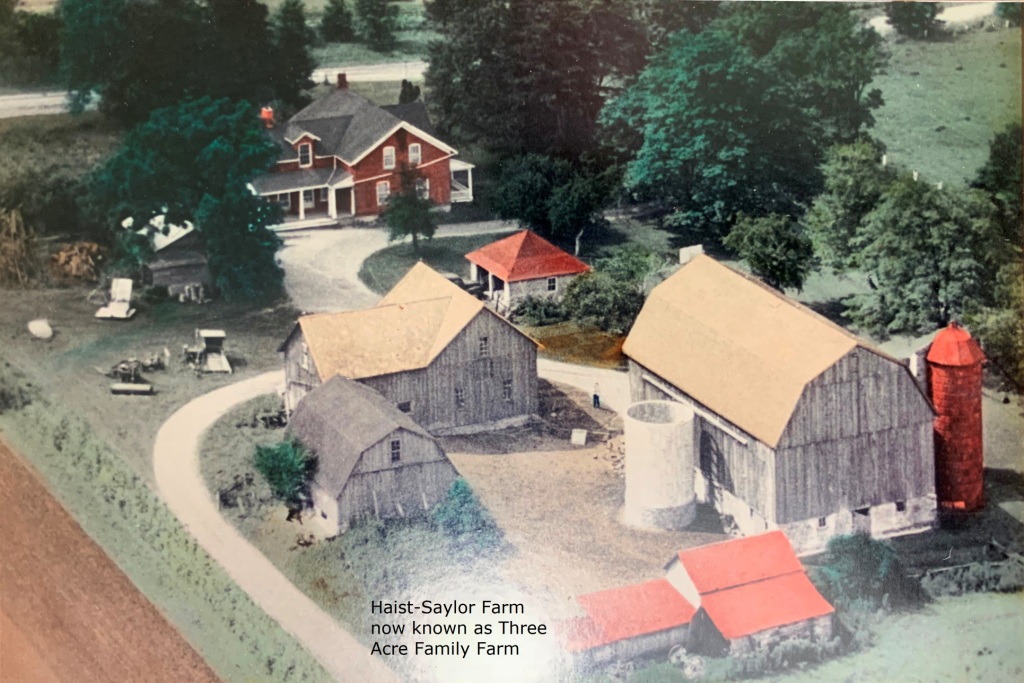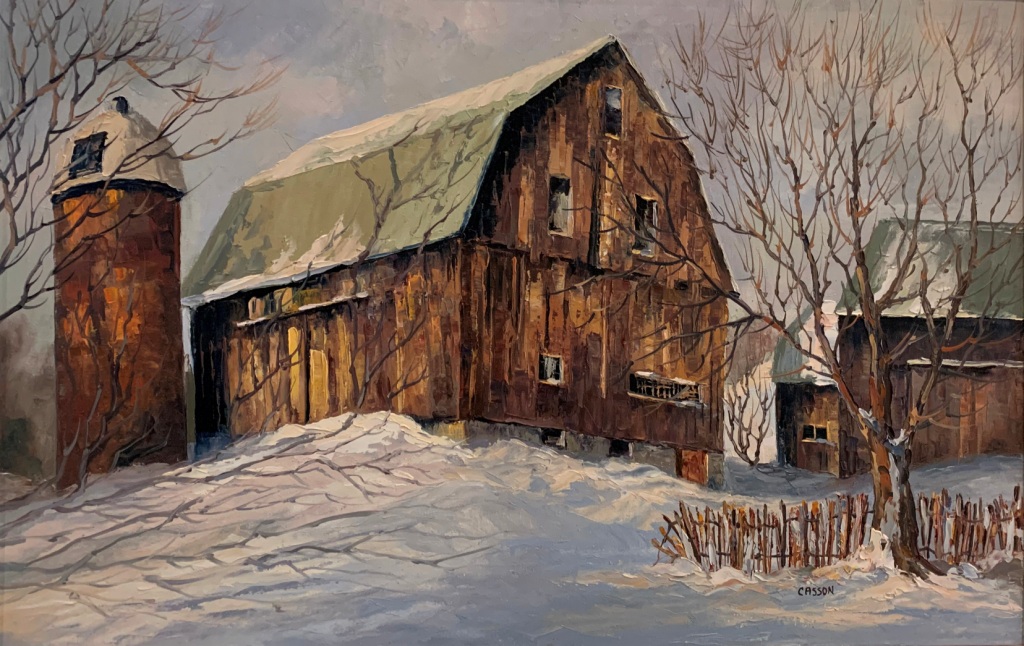Three Acres Family Farm and Barn consists of the farmhouse, barn, out-buildings and roughly 2.5 acres of surrounding land. This lot is part of a much larger 110 acre property known for many years as the Haist and then the Saylor Farm. That farm was carved out from the 1860 Short Hills Farm sub-division of Township of Pelham Concession VI, Lots 5 & 6 beginning in 1870. The high ground the farm sits on has had several names over the years. A British military commission, in a series of maps prepared between 1827 and 1850, described the area variously as St. George’s Mount, The Mountain, the Short Hills and Wellington Heights. In the late 18th century into the early 20th century the area immediately surrounding the farm was referred to as Mount Pleasant, Haist Mountain and, in the second half of the 20th century, as Saylor’s Hill.

There is little doubt that the high ground near the corner of Tice Road and Effingham Street had been part of the traditional territory of Indigenous nations for thousands of years before it was occupied by settlers of European descent. A nearby archaeological excavation produced evidence of a regular seasonal Indigenous encampment. The site was dated to at least 5,000 years ago (Middle Archaic / Brewerton period), with other finds from the more recent Late Archaic and Early Woodland periods. These discoveries provide perspective for land acknowledgement declarations.
The most significant defining period for this land, however, dates back 13,000+ years ago to the retreat of the ice fields. The melting ice pack stalled in this area and left a huge deposit of sand and gravel at the edge of Lake Warren (precursor of Lake Erie). This has come to be known as the six kilometre long by three kilometre wide Fonthill Kame-Delta though it may more properly be described as an Ice-contact Delta. At over 255 metres (836 feet) above sea level, the land beside Three Acres Family Farm is the highest elevation in the Niagara Peninsula. Toronto can be seen on a clear day. The farm is within the bounds of the Escarpment Protection Area of the Niagara Escarpment Plan.
The Land Patent for the 100 acres of Lot 5, Concession VI was granted in 1811. David Secord, an early mill operator in Effingham, acquired the land from the original grantee and then sold it to Jacob Wills in 1820. The Wills’ ownership was also relatively short, though moderately profitable as he bought at £250 and sold eight years later at £500. The buyer was none other than His Majesty, George the Fourth. The Crown bought these 200 acres in 1827 in anticipation of building a large fortress on this high ground. The Crown also made deposits on 500 adjacent acres, but did not complete those purchases.
The fortress idea was intended to act as a deterrent against the expansionist forces in the USA in the wake of the War of 1812, and to replace the poorly maintained and difficult to defend forts along the Niagara River. Over the course of 20 years many fine plans and maps of the fortress area were drafted.
In June of 1838, during this period when the Crown was contemplating a military fortress, a very different military operation was taking form just three kilometres away at Aaron Winchester’s woodlot. A group of mostly American insurrectionists had assembled in Pelham. They had hoped, incorrectly as it turned out, that the Reform leaning citizens of Pelham would join the armed rebellion against the British-supported establishment. This incursion force marched to nearby St. Johns and had a skirmish there with a group of Queen’s Lancers billeted at Osterhout’s Tavern. The outcome was not positive for the insurrectionists who were repulsed and dispersed or captured. One leader was hung and others transported to Van Diemen’s Land (Tasmania).
A combination of evolving priorities, budget re-allocations and a changing geo-political situation in North America determined that the fort would never be built. The 200 acres purchased by the Crown were sub-divided into eight 25 acre sub-lots described in a plan titled the Short Hills Farm.
Michael Haist, who had emigrated from Germany to Canada in the late 1840s, directly and indirectly purchased much of the property in the 1870s and then built the current farmhouse and a barn. He obtained several Ordnance Land Grant documents including one dated July 15, 1870 for the 48 acres and 22 perches of Sub-lots 3&4 of Concession VI, Lot 5. This is the south half of Lot 5 on the east side of Effingham. The original deed still exists.
Wheat was a common crop in late-18th century Pelham. It was threshed on this barn floor. Potatoes were a productive crop in the 20th century and poultry, dairy cattle and other livestock were raised. Michael Haist protected the fine tree in front of the unique terra cotta block silo (built after 1918).
On September 7, 1893 misfortune hit the Haist farm when a lightning strike set the barn on fire. Undeterred, Michael Haist and his sons immediately contracted for a new barn and two months later, with the help of 100 friends, family and neighbours, raised the current barn. The hand hewn swing beam in this barn is 36 feet long and 12 inches wide by 14 inches high. The barn is also categorized as a bank barn as two levels can be accessed at ground level.

This magnificent rendering of the barn was painted by Marilyn Gail (Haist) Casson 1940-2006, great grand-daughter of David Haist who was a brother of Michael Haist who built the barn.
The farm passed to Michael’s son Fred Haist in 1894 then to his grand-daughter Rita Lillian and her husband George Bradley Saylor in 1942. George lived on the farm until the age of 93. One of George’s granddaughters (and Michaels 2 x great-grandaughter, Caroline Alexander, with her husband, took over the home farm for another 18 years. A custom hand built bicycle manufacturer rented the lower level of the barn for a number of years in the 21st century and the barn was host to an annual May long weekend bicycle race, weddings and special events such as the Haist Family Reunion.
The Alexanders later sold the property to Dan Burke who did extensive renovation work before selling to the current owners – Geoffrey and Laura Tyler.
Three Acres Family Farm has witnessed the ebb and flow of the glaciers, thousands of years of indigenous peoples activity, natural disasters, geopolitical intrigue and several centuries of productive farming by industrious settlers.
